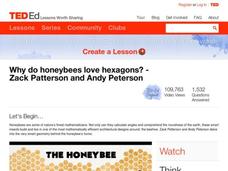TED-Ed
Why Do Honeybees Love Hexagons?
Float like a butterfly, think like a bee! Build a huge hive, hexagonally! Find out the reason that hexagons are the most efficient storage shape for the honeybees' honeycombs. This neat little video would be a sweet addition to...
TED-Ed
The Case of the Vanishing Honeybees
It's time for CSI: Honeybees! The numbers of domesticated honeybees in the US have been diminishing at an astounding rate, and investigators are out to find out why. The included video features three possible explanations and illuminates...
Curated OER
Giant Honey Bees - Life in the Undergrowth
The biggest of all honey bees are shown in this video: the giant honey bee. A brave researcher reaches extremely tall heights to show viewers how the bees protect themselves.
PBS
Career Connections | Agricultural Inspector
See what the buzz is all about! A short video details what it is like to be an agricultural inspector who specialized in apiaries.
California Academy of Science
Why Protect Pollinators?
Would you rather having biting flies or chocolate? The question may seem absurd, but cocoa trees rely on pollination from biting flies. Viewers come to understand the importance of pollinators to our food supply, flowers, and entire...
American Chemical Society
Did You Know Honey is Really Bee Puke?
Despite the title, here is a video that makes honey even sweeter! Biology scholars journey inside a beehive with a fascinating video from the American Chemical Society's Reactions playlist. Pupils learn about the social structure of a...
Kurzgesagt – In a Nutshell
The Death Of Bees Explained—Parasites, Poison and Humans
Maybe instead of humans dying off from a war, they will die as a result of a lack of food. The video discusses this possibility and why it is becoming more likely. It explains the importance of bees and the many different ways humans...
SciShow
Wasp Nests and Bee Hives
It turns out that wasps and bees have a lot more in common that the word ouch! Junior entomologists explore the similarities and differences between flying, stinging insects with the 136th installment in a 143-part series of science...
SciShow
What's Happening to Honey Bees?
Worker bees used to disappear at a rate of around 5 percent per year; then in 2006 that number jumped to 30 percent, and, by 2013, it was as high as 50 percent. The video focuses on what is happening to the honey bees. It considers...
SciShow
What Honeybees Can Teach Us About Democracy
While the United States has a representative democracy, honeybees have a true democracy. The video explains how honeybees vote, how they research their decision making process, and the importance of influencing others. It also describes...
Be Smart
How Do Bees Make Honey?
A queen bee may lay between 600-1,500 eggs per day during her three to four year reign. This fact and many others are contained in a video that shows scholars how bees turn nectar from flowers into honey, traveling thousands of miles to...
Curated OER
Honey Bees - Life Cycle
Bees are the best! Learn about the life cycle of honey bees, their history, and how important they are to our environment. A professional honey bee keeper describes the metamorphosis, hive construction, and life cycle of the bee. A very...
Curated OER
Beneficial Pollinators
Hone in on the honeybee and learn how you can help these important pollinators from going extinct. Honeybees play an important role in plant growth; encourage your young biologists and environmentalists to see the significance of these...
National Pest Managment Association
Pest World for Kids: Season 1: Episode 10
Watch three snippets about three household pests including: Honey, what's for dinner?, G'dday cousin opossum, and there's always room for dessert!
Science Friday Initiative
Science Friday: Getting the Springtime Buzz on Bees
A look at research into the behavior of bees as they work at pollinating flowers. Caffeine, which is present in nectar, turns out to be something that helps bees to remember types of flowers they have visited. Aired Mar. 8, 2013 [29:21 min]















